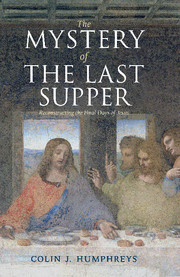Book contents
- Frontmatter
- Contents
- List of illustrations
- Foreword by I. Howard Marshall
- Acknowledgements
- 1 Four mysteries of the last week of Jesus
- 2 Dating the crucifixion – the first clues
- 3 The problem of the last supper
- 4 Can we reconstruct the Jewish calendar at the time of Christ?
- 5 The date of the crucifixion
- 6 The moon will be turned to blood
- 7 Did Jesus use the solar calendar of Qumran for his last supper Passover?
- 8 Does ancient Egypt hold a key to unlocking the problem of the last supper?
- 9 Discovering the lost calendar of ancient Israel
- 10 Was the lost ancient Jewish calendar used in Israel at the time of Jesus?
- 11 The date of the last supper: the hidden clues in the gospels
- 12 From the last supper to the crucifixion: a new analysis of the gospel accounts
- 13 A new reconstruction of the final days of Jesus
- Notes
- Bibliography
- Index of biblical and other ancient sources
- General index
10 - Was the lost ancient Jewish calendar used in Israel at the time of Jesus?
Published online by Cambridge University Press: 03 May 2011
- Frontmatter
- Contents
- List of illustrations
- Foreword by I. Howard Marshall
- Acknowledgements
- 1 Four mysteries of the last week of Jesus
- 2 Dating the crucifixion – the first clues
- 3 The problem of the last supper
- 4 Can we reconstruct the Jewish calendar at the time of Christ?
- 5 The date of the crucifixion
- 6 The moon will be turned to blood
- 7 Did Jesus use the solar calendar of Qumran for his last supper Passover?
- 8 Does ancient Egypt hold a key to unlocking the problem of the last supper?
- 9 Discovering the lost calendar of ancient Israel
- 10 Was the lost ancient Jewish calendar used in Israel at the time of Jesus?
- 11 The date of the last supper: the hidden clues in the gospels
- 12 From the last supper to the crucifixion: a new analysis of the gospel accounts
- 13 A new reconstruction of the final days of Jesus
- Notes
- Bibliography
- Index of biblical and other ancient sources
- General index
Summary
He [Jesus] came to a town in Samaria called Sychar, near the plot of ground Jacob had given to his son Joseph … Many of the Samaritans from that town believed in him … they urged him to stay with them, and he stayed two more days. And because of his words many more became believers. They said … ‘We know that this man really is the Saviour of the World.’
(John 4:5, 39–42)Today we use the Gregorian calendar. However, the earlier Julian calendar has persisted down to today and is still used by various groups (Greek Orthodox, Russian Orthodox, etc.) to calculate the date of Easter. In the previous chapter we discovered the lost pre-exilic Jewish calendar. Did Jesus choose to use this calendar to celebrate his last supper as a Passover meal, held at least one day before the date in the official Jewish calendar? Clearly he could only have done so if he knew about this calendar. Hence in this chapter I am going to ask the key question whether the pre-exilic calendar persisted down to the first century ad and whether it was used by one or more groups in Israel at the time of Jesus. We will start by considering the Samaritans.
THE SAMARITANS
The Samaritans are frequently mentioned in the gospels. For example, according to John 4, quoted above, Jesus had a group of followers in Samaria who declared him to be ‘the Saviour of the World’.
- Type
- Chapter
- Information
- The Mystery of the Last SupperReconstructing the Final Days of Jesus, pp. 135 - 150Publisher: Cambridge University PressPrint publication year: 2011

